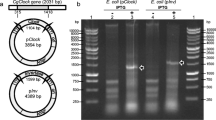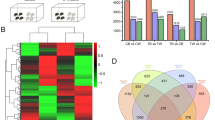Abstract
RNA interference (RNAi) is an important molecular tool for analysis of gene function in vivo. Although the Pacific oyster Crassostrea gigas is an economically important species with fully sequenced genome, very few mechanistic studies have been carried out due to the lack of molecular techniques to alter gene expression without inducing stress. In this present study, we used unicellular alga Platymonas subcordiformis and Nitzschia closterium f. minutissima as a vector to feed oysters with Escherichia coli strain HT115 engineered to express double-stranded RNAs (dsRNAs) targeting specific genes involved in shell pigmentation. A C. gigas strain with black shell was used to target tyrosinase or peroxidase gene expression by RNAi using the above-mentioned approach. The results showed that feeding oyster with dsRNA of tyrosinase could knock down the expression of corresponding tyrosinase and hinder the developed shell growth. Feeding oyster with dsRNA of peroxidase could knock down the expression of the corresponding peroxidase and result in reduced black pigmentation in the newly developed shell. This non-invasive RNAi study demonstrated that tyrosinase played a vital role in the assembly and maturation of shell matrices and peroxidase was essential for black pigmentation in the shell. Moreover, the RNA interference by ingested dsRNA-expressing bacteria is a relatively simple and effective method for knockdown of a gene expression in adult oysters, thus further advances the use of C. gigas as model organism in functional genomic studies.





Similar content being viewed by others
References
Arivalagan J, Marie B, Sleight VA, Clark MS, Berland S, Marie A (2016) Shell matrix proteins of the clam, Mya truncata: roles beyond shell formation through proteomic study. Mar Genom 27:69–74
Arivalagan J, Yarra T, Marie B, Sleight VA, Duvernois-Berthet E, Clark MS, Marie A, Berland S (2017) Insights from the shell proteome: biomineralization to adaptation. Mol Biol Evol 34:66–77
Berland S, Marie A, Duplat D, Milet C, Sire JY, Bédouet L (2011) Coupling proteomics and transcriptomics for the identification of novel and variant forms of mollusk shell proteins: a study with P. margaritifera. Chembiochem 12:950–961
Boettiger A, Ermentrout B, Oster G (2009) The neural origins of shell structure and pattern in aquatic mollusks. Proc Natl Acad Sci U S A 106:6837–6842
Budd A, McDougall C, Green K, Degnan BM (2014) Control of shell pigmentation by secretory tubules in the abalone mantle. Front Zool 11:62
Chakraborty SK, Singh DS, Kumbhar BK (2014) Influence of extrusion conditions on the colour of millet-legume extrudates using digital imagery. Irish J Agric Food Res 53:65–74
Christensen BM, Li J, Chen C-C, Nappi AJ (2005) Melanization immune responses in mosquito vectors. Trends Parasitol 21:192–199
Derby CD (2014) Cephalopod ink: production, chemistry, functions and applications. Mar Drugs 12:2700–2730
Doucette GJ (1995) Interactions between bacteria and harmful algae: a review. Nat Toxins 3:65–74
Du X, Fan G, Jiao Y et al (2017) The pearl oyster Pinctada fucata martensii genome and multi-omic analyses provide insights into biomineralization. GigaScience 6:gix059
Evans S, Camara MD, Langdon CJ (2009) Heritability of shell pigmentation in the Pacific oyster, Crassostrea gigas. Aquaculture 286:211–216
Fabioux C, Corporeau C, Quillien V, Favrel P, Huvet A (2009) In vivo RNA interference in oyster—vasa silencing inhibits germ cell development. FEBS J 276:2566–2573
Feng D, Li Q, Yu H, Zhao X, Kong L (2015) Comparative transcriptome analysis of the Pacific oyster Crassostrea gigas characterized by shell colors: identification of genetic bases potentially involved in pigmentation. PLoS One 10:e0145257
Feng D, Li Q, Yu H, Kong L, Du S (2017) Identification of conserved proteins from diverse shell matrix proteome in Crassostrea gigas: characterization of genetic bases regulating shell formation. Sci Rep 7:45754
Feng D, Li Q, Yu H, Kong L, Du S (2018) Transcriptional profiling of long non-coding RNAs in mantle of Crassostrea gigas and their association with shell pigmentation. Sci Rep 8:1436
Fire A, Xu S, Montgomery MK, Kostas SA, Driver SE, Mello CC (1998) Potent and specific genetic interference by double-stranded RNA in Caenorhabditis elegans. Nature 391:806–811
Ge J, Li Q, Yu H, Kong L (2014) Identification and mapping of a SCAR marker linked to a locus involved in shell pigmentation of the Pacific oyster (Crassostrea gigas). Aquaculture 434:249–253
Ge J, Li Q, Yu H, Kong L (2015) Identification of single-locus PCR-based markers linked to shell background color in the Pacific oyster (Crassostrea gigas). Mar Biotechnol 17:655–662
Gesualdo I, Aniello F, Branno M, Palumbo A (1997) Molecular cloning of a peroxidase mRNA specifically expressed in the ink gland of Sepia officinalis. Biochim Biophys Acta 1353:111–117
Hedgecock D, Shin G, Gracey AY, Van Den Berg D, Samanta MP (2015) Second-generation linkage maps for the Pacific oyster Crassostrea gigas reveal errors in assembly of genome scaffolds. G3 (Bethesda) 5:2007–2019
Hunter R (1975) Scales for the measurements of color difference. In: Hunter RS (ed) The measurements of appearance. Wiley, New York, pp 133–140
Huvet A, Béguel J-P, Cavaleiro NP et al (2015) Disruption of amylase genes by RNA interference affects reproduction in the Pacific oyster Crassostrea gigas. J Exp Biol 218:1740–1747
Ipsaro JJ, Joshua-Tor L (2015) From guide to target: molecular insights into eukaryotic RNA-interference machinery. Nat Struct Mol Biol 22:20–28
Jabbour-Zahab R, Chagot D, Blanc F, Grizel H (1992) Mantle histology, histochemistry and ultrastructure of the pearl oyster Pinctada margaritifera (L.). Aquat Living Resour 5:287–298
Knoll AH (2003) Biomineralization and evolutionary history. Rev Mineral Geochem 54:329–356
Li L, Li A, Song K, Meng J, Guo X, Li S, Li C, de Wit P, Que H, Wu F, Wang W, Qi H, Xu F, Cong R, Huang B, Li Y, Wang T, Tang X, Liu S, Li B, Shi R, Liu Y, Bu C, Zhang C, He W, Zhao S, Li H, Zhang S, Zhang L, Zhang G (2018) Divergence and plasticity shape adaptive potential of the Pacific oyster. Nat Ecol Evol 2:1751–1760
McDougall C, Degnan BM (2018) The evolution of mollusc shells. Wiley Interdiscip Rev Dev Biol 7:e313
Palumbo A (2003) Melanogenesis in the ink gland of Sepia officinalis. Pigment Cell Res 16:517–522
Papadakis SE (2000) A versatile and inexpensive technique for measuring colour of foods. Food Technol 54:48–51
Payton L, Perrigault M, Bourdineaud J-P, Marcel A, Massabuau J-C, Tran D (2017) Trojan horse strategy for non-invasive interference of clock gene in the oyster Crassostrea gigas. Mar Biotechnol 19:361–371
Pedreschi F, Leon J, Mery D, Moyano P (2006) Development of a computer vision system to measure the color of potato chips. Food Res Int 39:1092–1098
Renault T, Faury N, Barbosa-Solomieu V, Moreau K (2011) Suppression substractive hybridisation (SSH) and real time PCR reveal differential gene expression in the Pacific cupped oyster, Crassostrea gigas, challenged with Ostreid herpesvirus 1. Dev Comp Immunol 35:725–735
Rivera AS, Hammel JU, Haen KM, Danka ES, Cieniewicz B, Winters IP, Posfai D, Wörheide G, Lavrov DV, Knight SW, Hill MS, Hill AL, Nickel M (2011) RNA interference in marine and freshwater sponges: actin knockdown in Tethya wilhelma and Ephydatia muelleriby ingested dsRNA expressing bacteria. BMC Biotechnol 11:67
Sarathi M, Simon MC, Venkatesan C, Hameed AS (2008) Oral administration of bacterially expressed VP28dsRNA to protect Penaeus monodon from white spot syndrome virus. Mar Biotechnol 10:242–249
Schmittgen TD, Livak KJ (2008) Analyzing real-time PCR data by the comparative C(T) method. Nat Protoc 3:1101–1108
Schumpert CA, Dudycha JL, Patel RC (2015) Development of an efficient RNA interference method by feeding for the microcrustacean Daphnia. BMC Biotechnol 15:91
Slominski A, Tobin DJ, Shibahara S, Wortsman J (2004) Melanin pigmentation in mammalian skin and its hormonal regulation. Physiol Rev 84:1155–1228
Song J, Li Q, Yu Y, Wan S, Han L, Du S (2018) Mapping genetic loci for quantitative traits of golden shell color, mineral element contents, and growth-related traits in Pacific oyster (Crassostrea gigas). Mar Biotechnol 20:1–10
Takeo I, Sakai S (1961) Study of breeding of Japanese oyster, Crassostrea gigas. Tohoku J Agric Res 12:125–171
Teng W, Cong R, Que H, Zhang G (2018) De novo transcriptome sequencing reveals candidate genes involved in orange shell coloration of bay scallop Argopecten irradians. Chin J Oceanol Limnol 36:1408–1416
Tian H, Peng H, Yao Q, Chen H, Xie Q, Tang B, Zhang W (2009) Developmental control of a lepidopteran pest Spodoptera exigua by ingestion of bacteria expressing dsRNA of a non-midgut gene. PLoS One 4:e6225
Timmermans A (1998) Computer vision system for on-line sorting of pot plants based on learning techniques. Acta Hortic 421:91–98
Timmons L, Court DL, Fire A (2001) Ingestion of bacterially expressed dsRNAs can produce specific and potent genetic interference in Caenorhabditis elegans. Gene 263:103–112
Vavricka CJ, Han Q, Mehere P, Ding H, Christensen BM, Li J (2014) Tyrosine metabolic enzymes from insects and mammals: a comparative perspective. Insect Sci 21:13–19
Wang J, Li Q, Zhong X, Song J, Kong L, Yu H (2018) An integrated genetic map based on EST-SNPs and QTL analysis of shell color traits in Pacific oyster Crassostrea gigas. Aquaculture 492:226–236
Williams ST (2017) Molluscan shell colour. Biol Rev 92:1039–1058
Yam KL, Papadakis SE (2004) A simple digital imaging method for measuring and analyzing color of food surfaces. J Food Eng 61:137–142
Yu H, Zhao X, Li Q (2016) Genome-wide identification and characterization of long intergenic noncoding RNAs and their potential association with larval development in the Pacific oyster. Sci Rep 6:20796
Zhang G, Fang X, Guo X, Li L, Luo R, Xu F, Yang P, Zhang L, Wang X, Qi H, Xiong Z, Que H, Xie Y, Holland PWH, Paps J, Zhu Y, Wu F, Chen Y, Wang J, Peng C, Meng J, Yang L, Liu J, Wen B, Zhang N, Huang Z, Zhu Q, Feng Y, Mount A, Hedgecock D, Xu Z, Liu Y, Domazet-Lošo T, du Y, Sun X, Zhang S, Liu B, Cheng P, Jiang X, Li J, Fan D, Wang W, Fu W, Wang T, Wang B, Zhang J, Peng Z, Li Y, Li N, Wang J, Chen M, He Y, Tan F, Song X, Zheng Q, Huang R, Yang H, du X, Chen L, Yang M, Gaffney PM, Wang S, Luo L, She Z, Ming Y, Huang W, Zhang S, Huang B, Zhang Y, Qu T, Ni P, Miao G, Wang J, Wang Q, Steinberg CEW, Wang H, Li N, Qian L, Zhang G, Li Y, Yang H, Liu X, Wang J, Yin Y, Wang J (2012) The oyster genome reveals stress adaptation and complexity of shell formation. Nature 490:49–54
Acknowledgments
This study was supported by grants from the National Natural Science Foundation of China (31772843), the Fundamental Research Funds for the Central Universities (201762014), the Shandong Province (2017LZGC009), and the Taishan Scholars Seed Project of Shandong.
Author information
Authors and Affiliations
Contributions
D.D.F. performed the experiment, analyzed the data, and wrote the paper. Q.L. and H.Y. conceived and designed the study.
Corresponding author
Ethics declarations
Competing Interests
The authors declare that there is no conflict of interest.
Additional information
Publisher’s Note
Springer Nature remains neutral with regard to jurisdictional claims in published maps and institutional affiliations.
Electronic supplementary material
ESM 1
(PDF 14351 kb)
Supplementary Figure 1
(PDF 6355 kb)
Supplementary Figure 2
(PDF 6008 kb)
Supplementary Figure 3
(PNG 43 kb)
Rights and permissions
About this article
Cite this article
Feng, D., Li, Q. & Yu, H. RNA Interference by Ingested dsRNA-Expressing Bacteria to Study Shell Biosynthesis and Pigmentation in Crassostrea gigas. Mar Biotechnol 21, 526–536 (2019). https://doi.org/10.1007/s10126-019-09900-2
Received:
Accepted:
Published:
Issue Date:
DOI: https://doi.org/10.1007/s10126-019-09900-2




